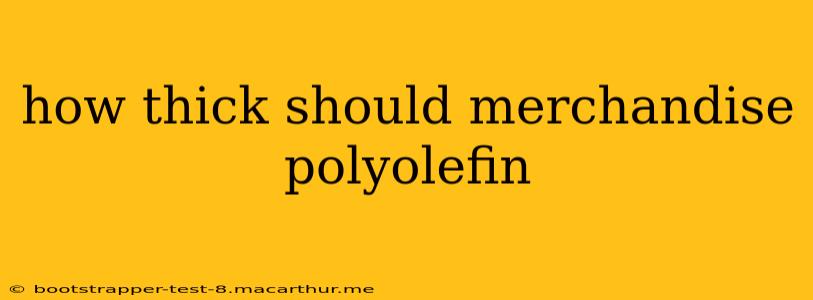Choosing the right thickness for your merchandise polyolefin bags is crucial for balancing product protection, presentation, and cost-effectiveness. There's no one-size-fits-all answer, as the ideal thickness depends on several factors. This comprehensive guide will help you determine the optimal thickness for your specific needs.
What is Polyolefin and Why is Thickness Important?
Polyolefin is a versatile plastic material known for its strength, flexibility, and clarity. It's a popular choice for merchandise bags due to its ability to protect products from dust, moisture, and minor damage during shipping and handling. The thickness, measured in mils (thousandths of an inch), directly impacts the bag's durability and overall performance. Thicker bags offer superior protection but at a higher cost, while thinner bags are more economical but may offer less protection.
Factors Affecting Polyolefin Bag Thickness Selection
Several factors should influence your decision regarding polyolefin bag thickness:
1. Product Weight and Fragility:
- Heavy or Fragile Items: Heavier or more fragile items require thicker bags (e.g., 2-4 mils or more) to prevent tears, punctures, and damage during transit. Consider the weight distribution within the bag as well – uneven weight distribution can stress thinner bags.
- Lightweight Items: For lighter, less delicate items, a thinner bag (e.g., 1-2 mils) might suffice, offering a cost-effective solution without sacrificing adequate protection.
2. Shipping and Handling Conditions:
- Rough Handling: If your products will experience rough handling during shipping, a thicker bag is essential to provide better protection against tears and punctures.
- Gentle Handling: For products that are handled gently, a thinner bag might be acceptable.
3. Desired Aesthetic:
- Premium Look: Thicker bags often appear more substantial and create a more premium feel, enhancing the perceived value of your product.
- Cost-Conscious Approach: Thinner bags offer a simpler and more economical solution.
4. Printing and Branding:
- Complex Designs: Thicker bags can better support detailed printing and branding without compromising the clarity or durability of the design.
- Simple Designs: Thinner bags are adequate for simple printing.
Common Polyolefin Bag Thicknesses and Their Applications
Here's a general guideline for polyolefin bag thickness and typical applications:
- 1-2 mils: Suitable for lightweight, non-fragile items requiring minimal protection; often used for promotional items or lightweight apparel.
- 2-3 mils: A good balance between protection and cost-effectiveness; ideal for moderately weighted items.
- 3-4 mils: Provides enhanced protection for heavier or more fragile items; commonly used for retail packaging of electronics or other delicate goods.
- 4+ mils: Offers superior protection for very heavy or fragile products, often used for specialized packaging or high-value items.
What Thickness is Best for My Merchandise?
Ultimately, the best way to determine the appropriate thickness for your merchandise polyolefin bags is through testing and experimentation. Consider ordering samples of different thicknesses to see how they perform with your specific products and shipping conditions. This hands-on approach ensures the optimal balance between protection, presentation, and cost.
How Can I Find Suppliers for Polyolefin Bags?
Several online retailers and packaging suppliers offer a wide selection of polyolefin bags in various thicknesses. Conduct thorough research, compare prices and options, and consider contacting multiple suppliers to ensure you find the best fit for your needs and budget. Remember to explicitly state your product requirements and shipping conditions when contacting suppliers to ensure they recommend the appropriate thickness.
This information should provide a solid foundation for your decision-making process. Remember to always prioritize the protection of your products and choose a thickness that reflects your specific needs and budget.
